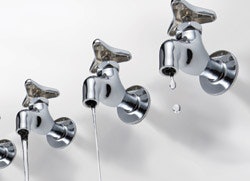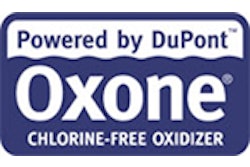
At the same time, driven by the imperative of energy conservation, a procession of states have begun lowering flow rates by forcing builders to install lowerhorsepower pumps and models with low-rpm capabilities.
The water is slowing, at least on new pools. It will take time, perhaps half a decade, before these changes penetrate the entire industry from coast to coast and include older pools, but with energy prices spiking, manufacturers are charging ahead with phase two of the revolution - reducing flow restriction and waste in pool-system components, including filters.
"I think that as an industry we're on the cusp of a major shift in terms of component design," says Steve Gutai, director, hydraulics products management, Jandy, Petaluma, Calif. Providing a quick summary of recent events, he says, "The California Energy Commission (CEC) has made recent changes to the Title 20 Appliance Efficiency Code. Beginning January '08, they are pushing customers toward using smaller-horsepower, two-speed or variable-speed pumps. This change will have an effect on the overall system and its performance."
Most pool-system components currently in service were designed to operate at higher flows and pressures. But now that pumps are being downsized, velocity of flow is slower, and many of these components find themselves incompatible.
"It's important to understand that every component is designed not only with a flow requirement but a pressure requirement," Gutai says. "You can take a bank of spa jets that requires 100 gpm, and if you put 100 gpm into it at 5 psi, the spa jets won't aerate properly because a higher pressure is required for the venturi to function properly, typically 15 to 20 psi. So if you try to use a low-speed pump in that situation it won't work.
"You need the higher pump speed to generate pressure. So the industry is moving to design equipment that will work properly with lower pressure and lower flow."
That's where the new development effort is being focused - designing components that will perform their function with water moving through them more slowly, under less pressure, and on reducing needless pinch points throughout the plumbing.
"What the industry is looking to do now," summarizes Frank Swindell, senior product manager of filters and valves, Pentair Water Pool and Spa, Sanford, N.C., "is take the restrictions in the line out.
"Now that the variable-speed pumps have come out, we want to start to generate filters that do not provide much back pressure. We want the water to flow through with less energy lost."
A Great Place To Start
Filtration is a great place to begin to address the issue of low flow in components because in general, even in existing products, the lower the flow rate, the better the filtration.
With water spending more time within the filter chamber, says Alan Levin, filtration engineer, Hayward Pool Products, Elizabeth, N.J., "there's more time to trap the particles."
By all accounts, however, cartridge filtration is the most energy efficient of the three main filter media - sand, DE and cartridge. That's not due to pressure loss differential as water passes through them, but from waste in the sand and DE cleaning processes.
Sand and DE filters have to be backwashed periodically to blow the filtrate off the sand bed or the DE filter grids. In order to do that, as these filters are currently designed, a valve must be incorporated to reverse the flow for the backwashing procedure.
That valve can be a power thief. It takes more energy to get the water through Pentair's 180-degree valve turn than it does to get it through the actual sand bed or DE filter, according to Swindell. "But with cartridge filtration," he says, "you don't normally have a valve."
However, in recent years, swimming pool equipment manufacturers have improved the performance of these valves. Some boast a mere one- to two-foot head loss, whereas traditional backwash valves would be in the range of seven to 10 feet.
Saving The Backwash
Typically, this same aspect of sand and DE filtration - backwashing - that results in unwanted TDH (total dynamic head) in the system, also draws consternation for wasting water.
Backwashing dumps a large amount of pool water into the sewer, while the cleaning process for a cartridge filter (basically just hosing off the filter element) requires a much lighter rinse.
"Wasting water is a big issue," says Mark Normyle, director of marketing, in-ground pumps and filters, Hayward Pool Products. "Some places are really hard hit, and even thinking about banning swimming pools. So saving water is important, and cartridge filters save a lot of backwash."
A final point to be made about the liability of backwashing is that it takes high-pressure water to accomplish. "If you try to run low-flow-rate water through a sand filter, when you go into backwash mode, you're not going to have enough flow to disrupt the surface of the sand bed and remove the top couple of inches of the sand bed and throw it into fluid, in order to backwash it," says Gutai.
Under Pressure
Beyond energy efficiency, flow rate has a large impact on cleaning and maintenance of filters. This is mostly due to the fact that a particle of debris moving fast under pressure will penetrate filter media far deeper than one moving more slowly.
And as anyone who has ever cleaned anything knows, deeply embedded dirt is more difficult to remove than dirt lying on the surface. If a cartridge filter is deeply penetrated with dirt through high-pressure flow, says Levin, "you really have to toss them rather than clean them."
All filters come with a recommended pressure differential or pressure drop across the filter. If they are maintained within those parameters, and cleaned regularly, he says, "you can use your cartridge filter at least one season and some people use them multiple seasons."
Patient Effort Required
It's a work in progress. The cost of energy - in terms of price paid in dollars by consumers, in political capital to oil-producing governments, and in degradation to the natural environment - has risen dramatically and the pool industry has no choice but to respond. Filters along with pumps and other components are undergoing transformation, just like the techniques of the builders and service techs that install them.
A tremendous, concurrent challenge is how to address the replacement market where, unlike new pool construction, all components and the pump are unlikely to be replaced together.
The goal is, eventually, to cut the pool industry's power bill in half, and have everything working at lower flow rate and pressure - pumps, filters and all.
Elbows Out
In the interests of providing a smooth flow path for circulating pool water with minimal restrictions, Jandy has included a cartridge filter within its Versa Plumb integrated equipment set, which reduces head loss in equipment plumbing.
The equipment set includes a pump with a sweep elbow - which is a very low-pressure-drop, low-friction-loss item, as opposed to hard-right-angle elbows that choke flow. The integrated system also uses an oversize filter, which saves energy by reducing the pressure drop across the filter and the number of cleanings required (with more filter material inside, the recommended cleaning interval is longer).
"We've been able to reduce a significant amount of the friction loss in the equipment set," says Steve Gutai, pool products manager, Jandy, Petaluma, Calif., "based on the fact that we use sweep elbows and the fittings and components are all designed to work together as a total system."
- S.W.
Hard To Handle
Energy savings notwithstanding, cartridge filter sales have benefited from the growing movement in urban areas to regulate DE.
"We're selling a lot more cartridge filters over DE," says Mark Normyle, director of marketing, in-ground pumps and filters, Hayward Pool Products, "because municipalities are requiring special handling and disposal of it. That adds another complication from the maintenance standpoint."
Even the backwashing of sand and DE filters using chlorinated pool water is drawing frowns from local governance, notes Steve Gutai, pool products manager, Jandy, Petaluma, Calif.
"More and more cities and townships are starting to pass codes that prohibit the disposing of swimming pool water in gutters, because they don't want chlorinated water in the system, and they don't want water with DE in it.
"So part of the reason people use cartridge filters in a lot of areas is that's all you can use."
- S.W.












































